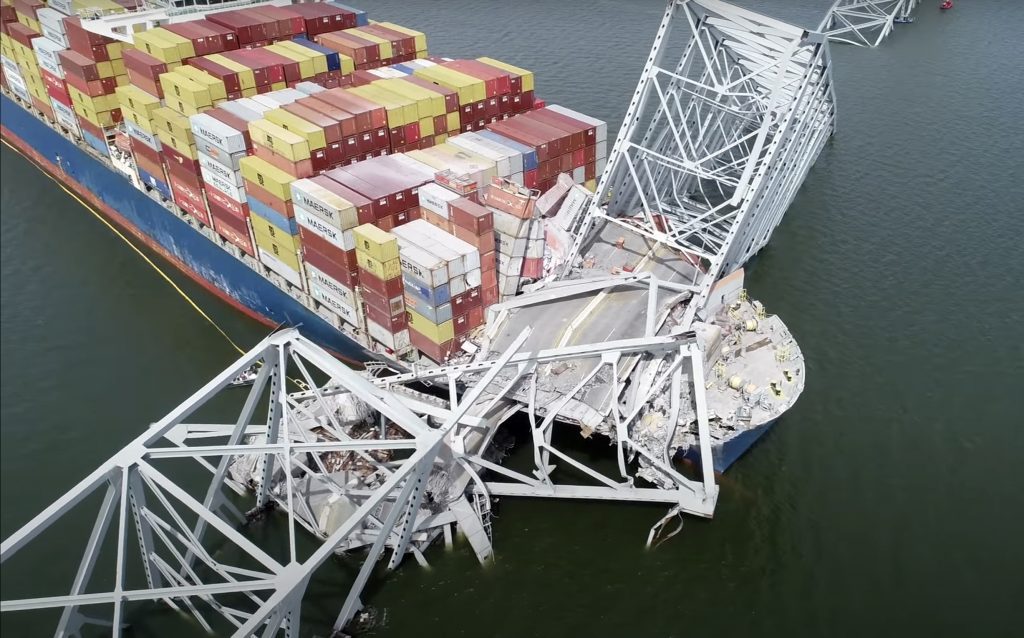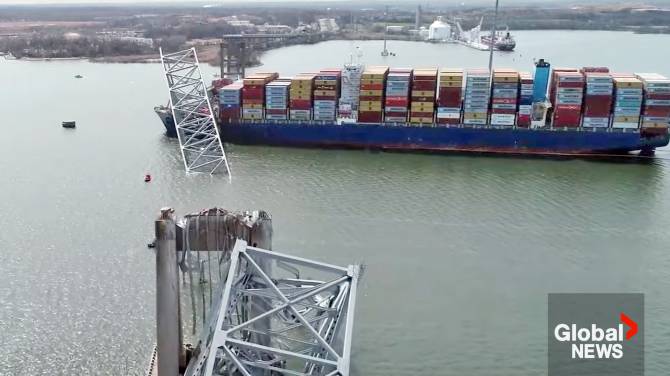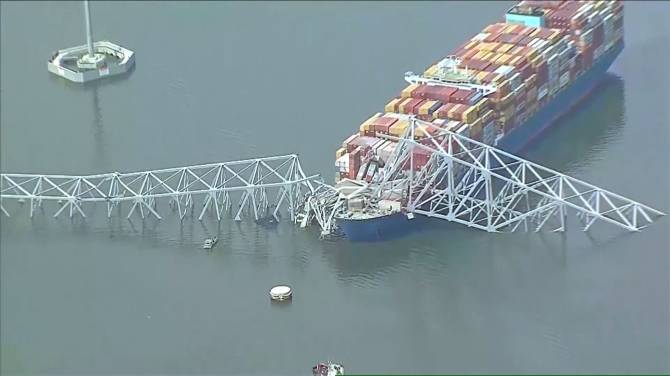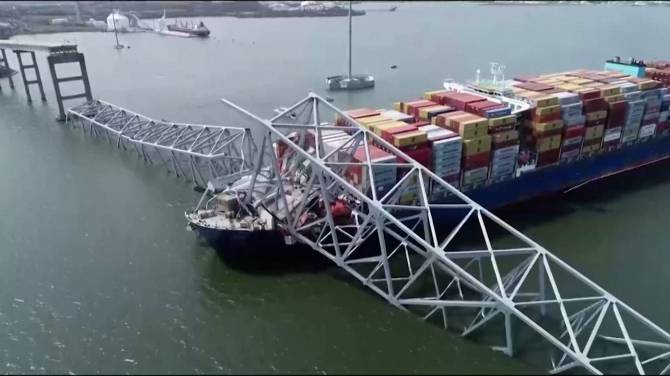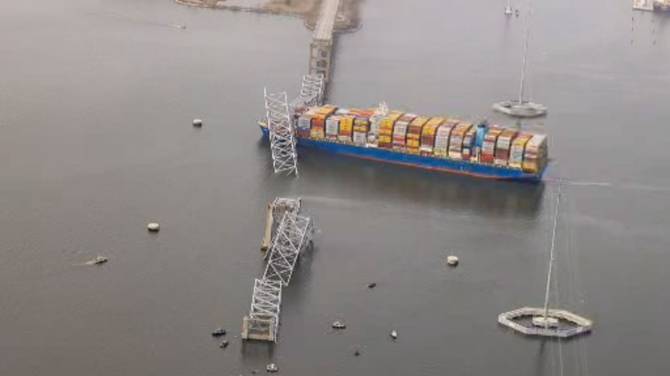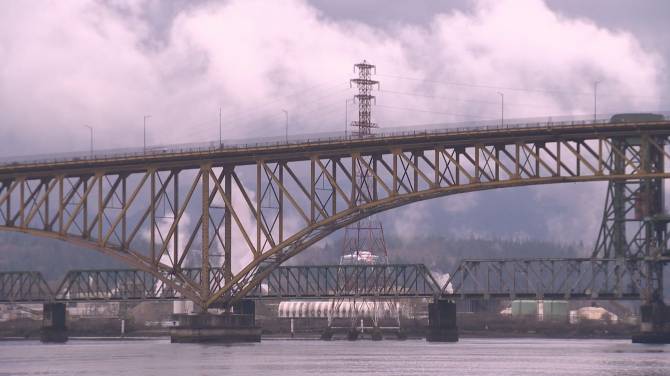The cargo ship that lost power and crashed into a bridge in Baltimore underwent routine engine maintenance before the incident, according to the U.S. Coast Guard. The bodies of six workers who fell into the water when the bridge collapsed have mostly been recovered, with two confirmed dead. Investigators started gathering evidence from the ship a day after it hit the Francis Scott Key Bridge. The bodies of the two men were found in the morning inside a red pickup truck submerged in about 25 feet of water near the bridge’s middle span, announced Col. Roland L. Butler Jr., superintendent of Maryland State Police, at a news conference.
The men were identified as Alejandro Hernandez Fuentes, 35, from Mexico, and Dorlian Ronial Castillo Cabrera, 26, from Guatemala. They were part of a construction crew fixing potholes on the bridge and were from Mexico, Guatemala, Honduras and El Salvador, according to Butler.
Maryland Gov. Wes Moore addressed the families of the victims in Spanish during the news conference, saying, “Estamos contigo, ahora y siempre,” meaning “we are with you, now and always.”
Search efforts have been exhausted, and authorities believe the other vehicles with victims are trapped in material from the collapsed bridge, based on sonar scans. Divers will resume searching once the debris is cleared, Butler said.
Coast Guard Rear Admiral Shannon Gilreath said in the news conference that they were informed the ship was going to undergo maintenance, adding, “As far as the engine goes, we were not informed of any problems with the vessel.”
The Baltimore region has been affected by the sudden loss of a major transportation link and the closure of the port, which is crucial to the city’s shipping industry.
National Transportation Safety Board officials boarded the ship to retrieve information from its electronics and paperwork, as well as to interview the captain and other crew members, NTSB Chair Jennifer Homendy said in a separate news conference. The ship had 56 containers of hazardous materials including corrosives, flammables and lithium ion batteries, some of which were breached.
Marcel Muise, NTSB investigator in charge, presented a preliminary timeline from the voyage data recorder, showing signs of trouble at about 1:25 a.m. when alarms were triggered. A minute later, steering commands and rudder orders were made, and at 1:26 a.m. and 39 seconds, a pilot radioed for nearby tug boats.
The Dali vessel left port at 12:39 a.m. Tuesday and encountered issues after about 45 minutes. Authorities have described the crash as an accident.
The ship was carrying not only the crew but also 56 containers of hazardous materials, some of which leaked into the water and necessitated a response from authorities.
The National Transportation Safety Board and other officials are investigating the ship's electronics and documents to determine the cause of the accident. Twenty-three people, including two pilots, were on board during the crash.
The accident has impacted the Baltimore region through the loss of a key transportation link and the closure of the port, which is essential for the city's shipping industry.
The ship, Dali, departed from port at 12:39 a.m. Tuesday and experienced issues about 45 minutes later. Both federal and state officials have indicated that the crash was an accident based on preliminary evidence.
The NTSB said that data from the Maryland Transportation Authority at around the same time indicates that the pilot association dispatcher contacted the transportation authority’s officer on duty regarding the blackout.
Immediately after 1:27 a.m., the pilot ordered the ship to drop an anchor on the left side and gave additional steering commands. Roughly 20 seconds later, the pilot communicated via radio that the Dali had lost all power as it neared the bridge.
At that time, the state transportation officer on duty radioed two units already stationed at each end of the bridge and instructed them to close the bridge to vehicle traffic, due to the ongoing construction.
Around 1:29 a.m., while the ship was traveling at about 8 mph (13 kph), recordings for about 30 seconds captured sounds consistent with it colliding with the bridge, as reported by the NTSB. A Transportation Authority dash camera also shows lights on the bridge going out.
At 1:29 a.m. and 39 seconds, the pilot notified the Coast Guard that the bridge was down.
Muise stated that experts will examine the entire voyage data recording and create a detailed transcript.
Initially, eight people went into the water when the ship hit the bridge column, and officials said that two of them were rescued on Tuesday.
As the ship approached, traffic was still crossing the span, and some vehicles seemed to escape at the last moment. The collision caused the bridge to break and fall into the water within seconds.
Authorities managed to halt vehicle traffic just in time. One officer parked sideways across the lanes and planned to drive onto the bridge to alert the construction crew once another officer arrived, but he did not get a chance.
According to a Homeland Security memo described to The Associated Press by an unnamed law enforcement official, the debris complicated the search for the workers.
Gov. Moore mentioned the challenging conditions faced by the divers, amidst the mangled metal and low visibility.
Moore said, 'They are down there in darkness where they can literally see about a foot in front of them.'
The Dali, managed by Synergy Marine Group, was en route from Baltimore to Sri Lanka. It is owned by Grace Ocean Private Ltd., and Danish shipping giant Maersk stated that it had chartered it.
The vessel underwent foreign port state inspections in June and September 2023. The June inspection rectified a faulty monitor gauge for fuel pressure before departure, according to Singapore’s port authority.
The ship was operating under a Singapore flag, and officials there stated that they will conduct their own investigation in addition to supporting U.S. authorities.
The sudden loss of a highway that carries 30,000 vehicles a day and the port disruption will impact not only thousands of dockworkers and commuters but also U.S. consumers who are likely to feel the impact of shipping delays.
Cat Watson, a daily commuter who lives close enough to be awakened by the collision, stated, 'A lot of people don’t realize how important the port is just to everything. We’re going to be feeling it for a very long time.'
Baltimore is a bustling entry point for cars manufactured in Germany, Mexico, Japan, and the United Kingdom, as well as coal and farm equipment.
Ship traffic has been halted indefinitely. Windward Maritime, a company that manages maritime risks, stated that its data indicates a significant increase in ships waiting to access a port, with some anchored outside Baltimore or nearby Annapolis.
At the White House, Transportation Secretary Pete Buttigieg mentioned that the Biden administration is focused on reopening the port and rebuilding the bridge, which was finished in 1977. He did not specify a timeline for these efforts, but noted that the original bridge took five years to build.
Buttigieg also scheduled a meeting with supply chain officials on Thursday.
Barges, some of which have cranes, were en route to assist in removing the wreckage, Gilreath stated.
Homendy said that the NTSB investigation could last 12 to 24 months, but the agency may issue urgent safety recommendations sooner. A preliminary report is expected in two to four weeks.
"It's a massive undertaking for an investigation," Homendy remarked.
From 1960 to 2015, there were 35 significant bridge collapses globally due to ship or barge collisions, according to the World Association for Waterborne Transport Infrastructure.


